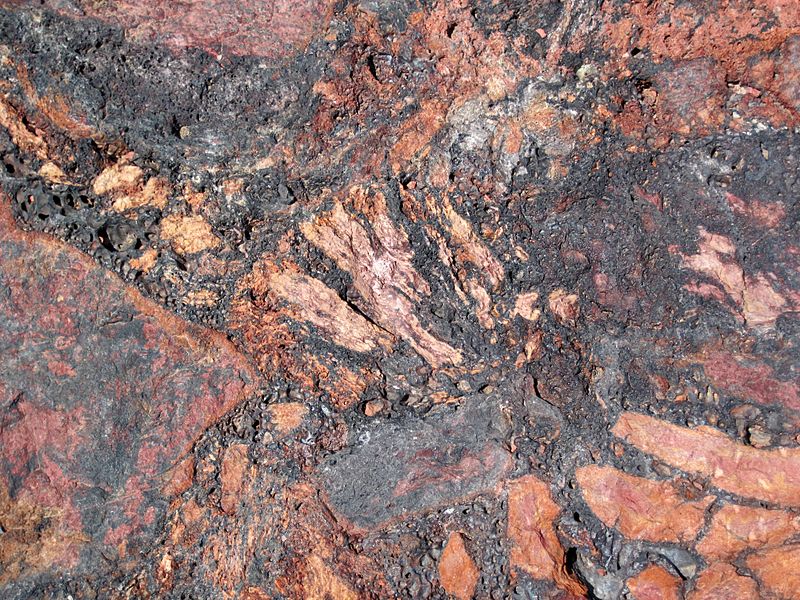Image: Clinker-bed breccia (Wasatch Formation, Lower Eocene; coal fire metamorphism at 19 ka, Late Pleistocene; large block at Interstate 90 west-bound hilltop rest area, east of Buffalo, Powder River Basin, Wyoming, USA) 4 (19942408800)

Description: Clinker-bed breccia in Wyoming, USA. Clinker is a scarce, odd rock. It occurs adjacent to former coal bed horizons. Coal is combustible (that’s why coal is used as an energy source in human society). Coal beds can ignite accidentally or naturally. Accidental coal bed ignition often leads to environmental disaster areas (for example, Centralia, Pennsylvania, USA). Natural coal bed fires can be initiated by lightning strikes, grass fires, forest fires, or spontaneous combustion. Some ancient coal beds in the geologic record have burned away, leaving behind clinker beds. “Clinker” is the term for thermal metamorphic rocks (combustion metamorphic rocks) that have been significantly altered by the heat of burning coal beds. The appearance and color of clinker varies significantly. Scoriaceous to semivitreous clinker is called buchite, which formed by partial fusion/melting. Some sedimentary rocks adjacent to coal fires have melted to form paralava. Subsequent cooling and shrinking can form pseudocolumnar jointing in clinker horizons. Non-vesicular clinker that resembles unglazed porcelain is called porcellanite (a.k.a. porcelanite). Clinker having numerous, differently-oriented, angular clasts jumbled together is called clinker-bed breccia, which forms by shifting and collapse of beds overlying a burned-out coal horizon. Some early explorers of the American Great Plains, not knowing the non-volcanic origin of this material, called natural clinker “pumice” or “scoria”. Clinker is still called "scoria" today in Wyoming, Montana, and North Dakota, where clinker horizons are common and conspicuous; they frequently cap hilltops and buttes. The terms "buchite" and "porcellanite" are not restricted to clinker lithologies. To prevent confusion, these terms should always be combined with the term "clinker" to refer to rock types associated with coal fires (i.e., "buchite clinker" and "porcellanite clinker"). Stratigraphy & age: siliciclastic sedimentary rock overlying the Healey-Ucross/Lake de Smet Coal Zone in the Wasatch Formation (Lower Eocene), thermally metamorphosed by a coal fire at 19 ka (near-latest Pleistocene) Locality: large loose block at Interstate 90 west-bound hilltop rest area, east of the town of Buffalo, northern Johnson County, western Powder River Basin, northern Wyoming, USA (44° 20' 23.40" North, 106° 37' 52.24" West) Example references on clinker of the Powder River Basin: Foit, F.F., R.L. Hooper & P.E. Rosenberg. 1987. An unusual pyroxene, melilite, and iron oxide mineral assemblage in a coal-fire buchite from Buffalo, Wyoming. American Mineralogist 72: 137-147. Heffern, E.L., P.W. Reiners, C.W. Naeser & D.A. Coates. 2007. Geochronology of clinker and implications for evolution of the Powder River Basin landscape, Wyoming and Montana. Geological Society of America Reviews in Engineering Geology 18: 155-175. Heffern, E.L., P.W. Reiners & C.A. Riihimaki. 2013. Clinker distribution and age in the Powder River Structural Basin. Montana Bureau of Mines and Geology Geologic Map 64.
Title: Clinker-bed breccia (Wasatch Formation, Lower Eocene; coal fire metamorphism at 19 ka, Late Pleistocene; large block at Interstate 90 west-bound hilltop rest area, east of Buffalo, Powder River Basin, Wyoming, USA) 4 (19942408800)
Credit: Clinker-bed breccia (Wasatch Formation, Lower Eocene; coal fire metamorphism at 19 ka, Late Pleistocene; large block at Interstate 90 west-bound hilltop rest area, east of Buffalo, Powder River Basin, Wyoming, USA) 4
Author: James St. John
Usage Terms: Creative Commons Attribution 2.0
License: CC BY 2.0
License Link: https://creativecommons.org/licenses/by/2.0
Attribution Required?: Yes
Image usage
The following page links to this image:

